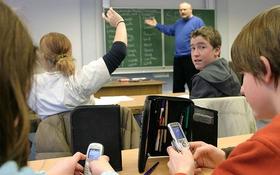Top Rankings
Pine Ridge Job Corps School District ranks among the top 20% of public school district in Nebraska for:
Category
Attribute
Diversity
Most diverse schools (Top 1%)
Student Attention
Lowest student:teacher ratio (Top 1%)
For the 2025 school year, there is 1 public school serving 36 students in Pine Ridge Job Corps School District.
Public Schools in Pine Ridge Job Corps School District have a diversity score of 0.65, which is more than the Nebraska public school average of 0.57.
Minority enrollment is 50% of the student body (majority Hispanic), which is more than the Nebraska public school average of 38% (majority Hispanic).
Overview
This School District
This State (NE)
# Schools
1 School
1,100 Schools
# Students
36 Students
328,496 Students
# Teachers
4 Teachers
24,032 Teachers
Student : Teacher Ratio
9:1
9:1
District Rank
The school district's graduation rate of 20% has decreased from 20-24% over five school years.
Math Test Scores (% Proficient)
(18-19)<50%
52%
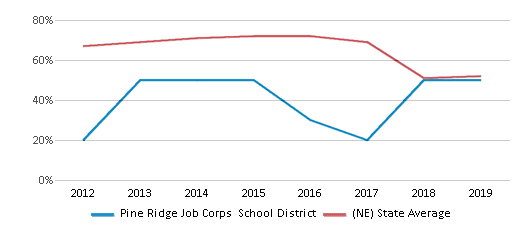
Reading/Language Arts Test Scores (% Proficient)
(18-19)<50%
52%
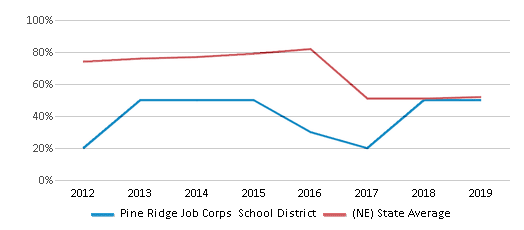
Graduation Rate
≤20%
87%
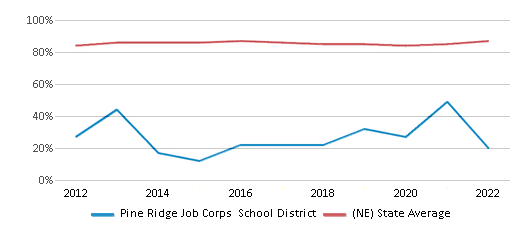
Students by Ethnicity:
Diversity Score
0.65
0.57
# American Indian Students
1 Student
4,353 Students
% American Indian Students
3%
1%
# Asian Students
n/a
10,108 Students
% Asian Students
n/a
3%
# Hispanic Students
11 Students
73,597 Students
% Hispanic Students
30%
22%
# Black Students
4 Students
21,317 Students
% Black Students
11%
7%
# White Students
18 Students
203,278 Students
% White Students
50%
62%
# Hawaiian Students
1 Student
560 Students
% Hawaiian Students
3%
n/a
# Two or more races Students
1 Student
15,283 Students
% of Two or more races Students
3%
5%
Students by Grade:
# Students in PK Grade:
-
19,504
# Students in K Grade:
-
22,318
# Students in 1st Grade:
-
22,898
# Students in 2nd Grade:
-
23,457
# Students in 3rd Grade:
-
23,201
# Students in 4th Grade:
-
23,506
# Students in 5th Grade:
-
23,198
# Students in 6th Grade:
-
23,396
# Students in 7th Grade:
-
23,395
# Students in 8th Grade:
-
24,061
# Students in 9th Grade:
-
25,222
# Students in 10th Grade:
5
25,356
# Students in 11th Grade:
9
23,606
# Students in 12th Grade:
22
25,378
# Ungraded Students:
-
-
Best Pine Ridge Job Corps School District Public Schools (2025)
School
(Math and Reading Proficiency)
(Math and Reading Proficiency)
Location
Grades
Students
Rank: #11.
Pine Ridge Job Corps
(Math: <50% | Reading: <50% )
Rank:
Rank:
4/
Bottom 50%10
15710 Hwy 385
Chadron, NE 69337
(308) 432-8650
Chadron, NE 69337
(308) 432-8650
Grades: 10-12
| 36 students
Frequently Asked Questions
How many schools belong to Pine Ridge Job Corps School District?
Pine Ridge Job Corps School District manages 1 public schools serving 36 students.
What is the racial composition of students in Pine Ridge Job Corps School District?
50% of Pine Ridge Job Corps School District students are White, 30% of students are Hispanic, 11% of students are Black, 3% of students are American Indian, 3% of students are Hawaiian, and 3% of students are Two or more races.
What is the student/teacher ratio of Pine Ridge Job Corps School District?
Pine Ridge Job Corps School District has a student/teacher ratio of 9:1, which is lower than the Nebraska state average of 14:1.
Recent Articles
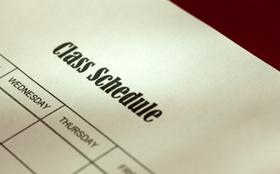
Year-Round Or Traditional Schedule?
Which is more appropriate for your child? A year-round attendance schedule or traditional schedule? We look at the pros and cons.

Why You Should Encourage Your Child to Join a Sports Team
Participating in team sports has a great many benefits for children, there is no doubt. In this article you will learn what those benefits are.

White Students are Now the Minority in U.S. Public Schools
Increasing birth rates among immigrant families from Asia and Central and South America, combined with lower birth rates among white families, means that for the first time in history, public school students in the United States are majority-minority. This shift in demographics poses difficulties for schools as they work to accommodate children of varying language abilities and socio-economic backgrounds.

